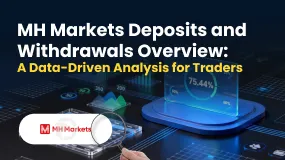WIKIFX REPORT: How to achieve perfect traceability
Abstract:You can't manage it if you can't trace it! In this post, we'll look at a facet of money management that's sometimes ignored yet crucial: traceability. End-to-end traceability improves FX management quality and eliminates wasteful expenses and operational hazards.

When you you can‘t trace it, you can’t manage it! In this article, we will discuss an overlooked but important feature in currency management: traceability. End-to-end traceability enhances the quality of FX management and allows you to remove unnecessary costs and operational risks.
What is traceability?
Depending on the sector, traceability could means many things. From an accounting perspective, traceability is the ability to follow a business transaction back to the originating document. It is a key concept for auditors as they need systems with a high degree of traceability to assist them in verifying the transactions included in financial statements.
Traceability gives you the chance to pinpoint the exact place where something has gone wrong, and to organize product callbacks whenever a pervading fault in a batch is detected. Even more importantly, having certain traceability-related policies in place could give you the chance to avoid product non-conformity that could be traced back to your company.
From the point of view of industrial applications, traceability is about identifying products throughout the supply chain and supporting supply chain visibility. Obviously, this can be a major concern in industries with health or environmental concerns.
Traceability in the context of foreign exchange managementTraceability in the context of foreign exchange management
Now let's see what does traceability mean in the context of foreign currency management? Individual pieces of exposure are known as entries. Entries are grouped into positions. When positions are hedged, they become operations, and they can lead to single or multiple payments.
Traceability is the fact that each element has its own unique reference number in the journey from entry to payment. In addition, payments carry the operation reference within their SWIFT message, allowing funds to be traced throughout the entire payment process.
Whenever a position is hedged, it is possible to trace it back to the original entries, including the exchange rate. Thats what Currency Management Automation does. We call it perfect end-to-end traceability
An overlooked, but essential element in currency management
Let us introduce two examples that allow us to understand the importance of traceability in the context of currency management.
When individual pieces of exposures are aggregated, you may benefit from lower trading costs and perhaps more time for scanning netting opportunities and even savings in terms of forward points if they are not in your favour. But, in the absence of perfect traceability, youd be hard-pressed to calculate your profit margins adequately. It would be quite challenging to determine what purchase corresponds to what sale and at what exchange rate each transaction took place.
In the context of a combination of hedging programs for which you want to apply Hedge Accounting, if the budgeted exposure has been hedged, you still need to process firm sales/purchase orders. But why? This is Because in order to compile the required documentation, you need to trace these hedged items to the corresponding hedging instrument, including its value date and exchange rate. This would be an extremely time-consuming activity in the absence of perfect traceability.
Therefore in summary, Traceability is an important yet somewhat neglected concept. You are unlikely to find many references to traceability in textbooks on FX management. It allows treasurers to drill down to the smallest piece of exposure to obtain the required data granularity.
Read more

Garanti BBVA Securities Exposed: Traders Report Unfair Charges & Poor Customer Service
Have you been financially ruined through chargebacks allowed by Garanti BBVA Securities? Do you have to wait for hours to get your queries resolved by the broker’s customer support official? Did the same scenario prevail when you contact the officials in-person? Failed to close your account as Garanti BBVA Securities officials remained unresponsive to your calls? Many have expressed similar concerns while sharing the Garanti BBVA Securities review online. In this article, we have shared some complaints against the broker. Take a look!

In-Depth Review of Stonefort Securities Withdrawals and Funding Methods – What Traders Should Really
For any experienced forex and CFD trader, the mechanics of moving capital are as critical as the trading strategy itself. The efficiency, security, and transparency of a broker's funding procedures form the bedrock of a trustworthy, long-term trading relationship. A broker can offer the tightest spreads and the most advanced platform, but if depositing funds is cumbersome or withdrawing profits is a battle, all other advantages become moot. This review provides a data-driven examination of Stonefort Securities withdrawals and funding methods. We will dissect the available information on payment options, processing times, associated costs, and the real-world user experience. Our analysis is anchored primarily in data from the global broker regulatory inquiry platform, WikiFX, supplemented by a critical look at publicly available information to provide a comprehensive and unbiased perspective for traders evaluating this broker.

MH Markets Deposits and Withdrawals Overview: A Data-Driven Analysis for Traders
For any experienced trader, the integrity of a broker is not just measured by its spreads or platform stability, but by the efficiency and reliability of its financial plumbing. The ability to deposit and, more importantly, withdraw capital without friction is a cornerstone of trust. This review provides an in-depth, data-driven analysis of the MH Markets deposits and withdrawals overview, examining the entire fund management lifecycle—from funding methods and processing speeds to fees and potential obstacles. MH Markets, operating for 5-10 years under the name Mohicans Markets (Ltd), has established a global footprint. With a WikiFX score of 7.08/10, it positions itself as a multi-asset broker offering a range of account types and access to the popular MetaTrader platforms. However, for a discerning trader, the real test lies in the details of its payment systems and the security of their funds. This article dissects the MH Markets funding methods withdrawal experience, leveraging pr

GAIN Capital Review: Exploring Complaints on Withdrawal Denials, Fake Return Promises & More
Is your forex trading experience with GAIN Capital full of financial scams? Does the broker disallow you from withdrawing your funds, including profits? Have you been scammed under the guise of higher return promises by an official? Does the GAIN Capital forex broker not have an effective customer support service for your trading queries? Concerned by this, many traders have shared negative GAIN Capital reviews online. In this article, we have discussed some of them. Read on!
WikiFX Broker
Latest News
GCash Rolls Out Virtual US Account to Cut Forex Fees for Filipinos
WikiFX's New Evaluation of ATM Capital LTD: Does its License Protect the Arab Investor?
How a Fake Moomoo Ad Led to the “New Dream Voyage 5” Scam
Is Axi Legit? A Data-Driven Analysis of Its Regulatory Standing and Trader Feedback
Trive Investigation: High Score, Hidden Risk - The Profit Paradox
In-Depth Uniglobe Markets Commission Fees and Spreads Analysis – What Traders Should Really Know
FXPesa Review: Are Traders Facing High Slippage, Fund Losses & Withdrawal Denials?
CMC Markets Australia Revenue Surges 34%, But High-Net-Worth Clients Face Tax Phishing Threat
The 350 Per Cent Promise That Cost Her RM604,000
INZO Commission Fees and Spreads Breakdown: A 2025 Data-Driven Analysis for Traders
Rate Calc


